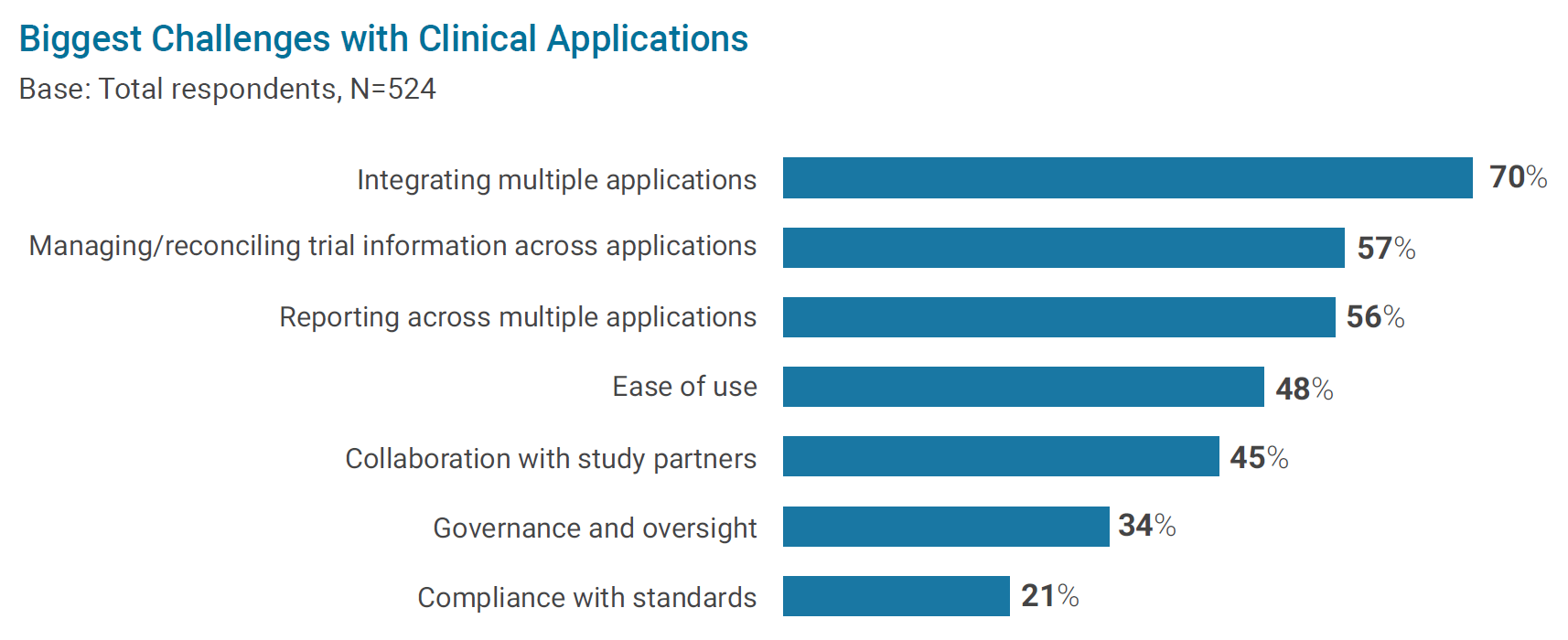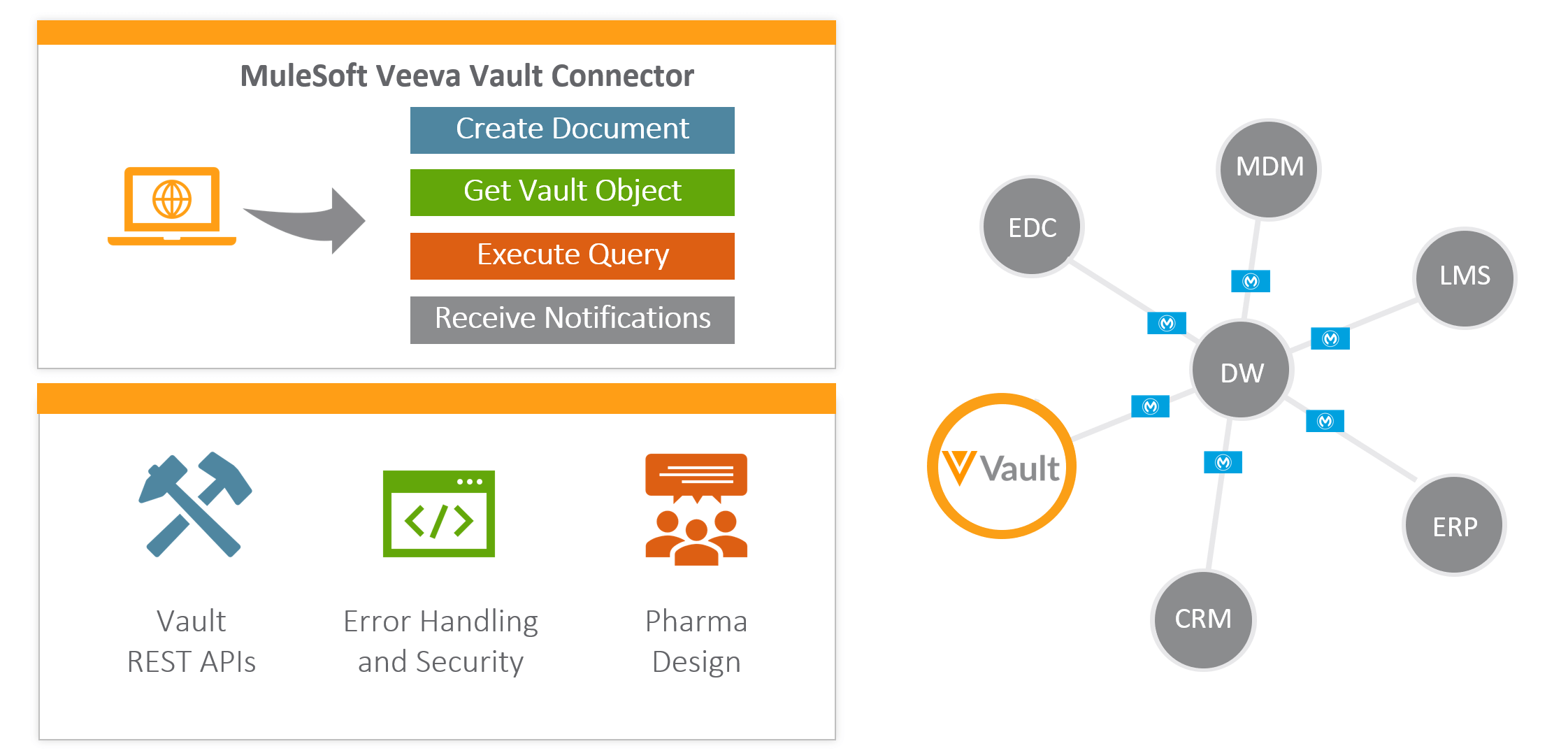Accelerating Clinical Development with Cloud Integration
The Veeva 2020 Unified Clinical Operations Survey Report uncovered that life sciences companies rank integrating multiple applications as their top challenge with clinical technology.
As a result, life sciences companies are adopting API-led strategies so their investments in accessing and extending their core assets and processes can return greater value. With an API-led strategy, these systems can now utilize increased automation, making it far easier to coordinate with adjacent programs. Using this approach, the investments around accessing clinical trial management systems, R&D systems, and trial observation systems are reusable for other integration patterns. The same definition of a concept, like an adverse event, is relevant both during a trial and once approved. By using an API-led strategy, these definitions can be built once, reused many times, and become the composable foundation for many other types of integrations such as:
- EDC – CTMS – AP
- ePRO – EDC – CTMS
- EDC – CTMS – Data Lake (analytics)
- Sponsor CTMS – CRO CTMS
- Data warehouses and business intelligence tools
This new approach centered around APIs powers the composable enterprise, breaking down data silos and creating a technical foundation built for reusability, scale, and consumption. Across the product development life cycle, processes like site scoring and selection, document compilation and review, and patient enrollment can be packaged and productized into reusable APIs. This dramatically accelerates R&D innovation by connecting systems, applications, and data more efficiently and at a fraction of the cost.
Together Veeva and MuleSoft have developed an out-of-the-box solution to help life sciences organizations realize the full potential of both the API-led integration strategy of MuleSoft and the end-to-end business process automation capabilities of Veeva Vault.
The MuleSoft Veeva Vault Connector
The MuleSoft Veeva Vault Connector provides a common integration platform that makes it easy to move data between Veeva Vault and other third-party applications — without the need to develop or maintain costly custom code. This approach saves time and money, accelerates implementation, and allows companies to develop secure and compliant integrations at scale.
Let’s take a deeper look at how life sciences companies leverage MuleSoft and Veeva together.
Top 20 pharma connects to 25+ applications and improves data quality
A primary driver to modernize clinical operations for this global top 20 pharma was to simplify the technology landscape and remove the complexities of disconnected systems. Duplicate, inaccurate data and lags between systems resulted in users reverting to local spreadsheets, ultimately causing distrust in the data.
The pharma company decided to invest in the Vault Clinical Operations Suite to transform clinical operations. They needed to connect to over 25 other applications and enable Clinical Vault as the central repository for all study data. To expedite integration development, they used the MuleSoft connector to easily connect applications. They now have a single source of truth and a data hub to enable data-driven decision making.
Top 25 pharma quickly migrates legacy study data and reuses APIs
A top 25 pharma selected Vault CTMS to replace their legacy Oracle Siebel CTMS and modernize clinical delivery. Their point-to-point legacy integration approach was inflexible and not scalable, so they turned to MuleSoft to help them connect systems faster.
The company took an API-first approach to integrate systems such as EDC and IRT to Vault CTMS and migrated archived study data from their legacy CTMS. They expect to build 60-80 APIs and reuse 40-60% of their integration assets, driving faster time to development than ever before.
Rapidly share data between sponsors and CROs to improve oversight
As more clinical studies are outsourced to CROs, better collaboration is needed for sponsors to demonstrate effective study oversight to regulators. Traditional approaches to collaboration, such as a batch upload of CRO data on a one-off basis, are not scalable, especially when sponsors work with multiple CROs on a single study. Sponsors need visibility to key CTMS records such as:
- Issues (including protocol deviations)
- Monitoring events
- Study risk assessments
- Metrics
- Serious adverse events
- Milestones
- Tasks
MuleSoft’s API-first approach unlocks data and services from the CRO CTMS, operational data store, and other legacy systems. APIs also allow internal applications and external consumers to receive consistent, real-time access to R&D data, allowing for collaboration across a disparate ecosystem of applications. A fully comprehensive view into the entire clinical trial process also offers life sciences organizations the visibility needed for compliance with ICH GCP regulations for study oversight.
Life sciences companies are unlocking data silos and integrating critical data across hundreds of systems to speed clinical trials. Watch this 2-minute demo to see an overview of how they’re doing it with the MuleSoft Veeva Vault Connector.



